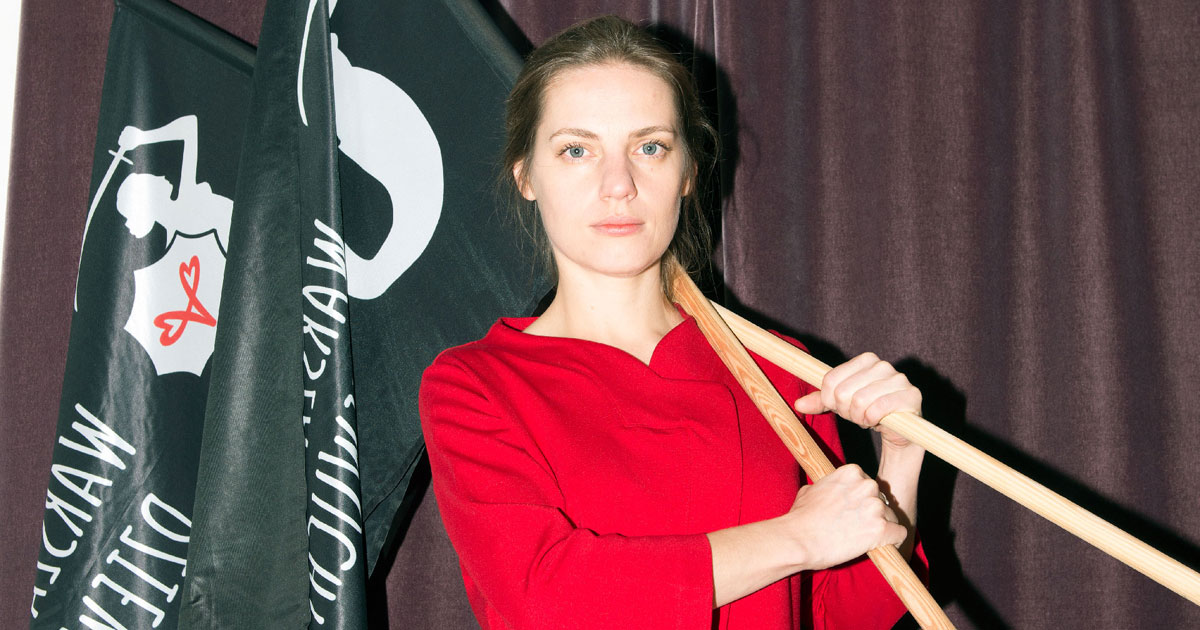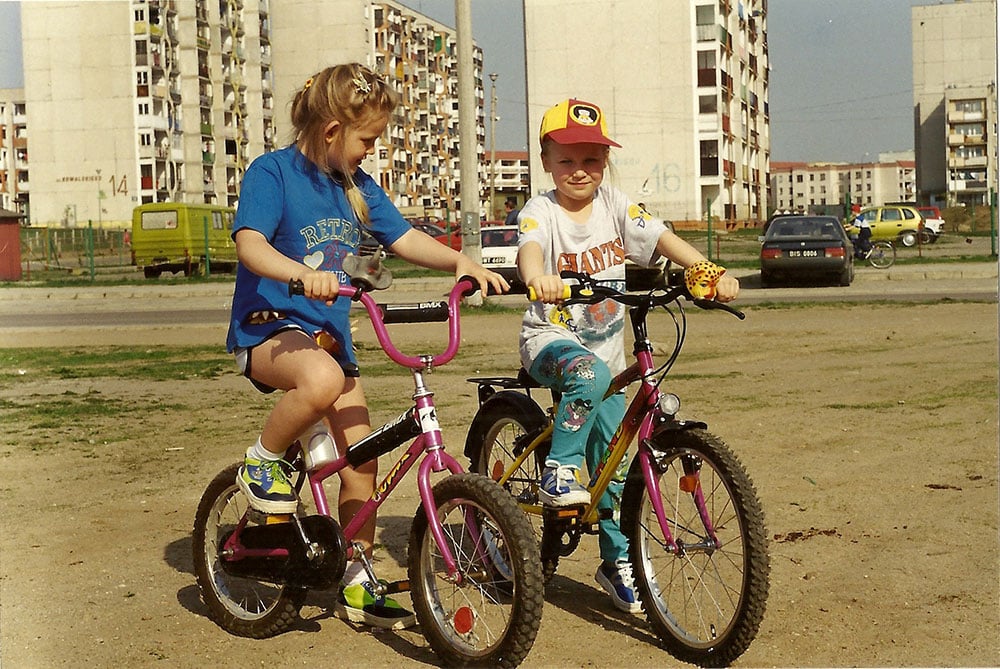Once upon a time in the East: a genre-bending Polish dystopia offers a parable for our troubled times
Poland’s politicians have long embraced the cause of so-called “traditional values” — but what if ancient medieval laws, the Albanian Kanun, really did rule the streets of Warsaw? Piotr Adamski explores family ties and friendship in an unsettling Slavic-Western-cum-feminist-dystopia.
Any post-lockdown premiere is an unnerving experience. Eerily empty rows, masked ushers, the lingering smell of disinfectant: the once-familiar trip to the cinema now feels markedly off. In the case of Eastern, Polish director Piotr Adamski’s first full-length feature, the feeling of unease also oozes from the screen itself. Adamski’s Slavic-Western-cum-feminist-dystopia paints a world which Polish audiences instantly recognise: sprawling suburbia, gated communities, and high-gloss fitted kitchens, the fusty air of lawyers’ offices and university examination rooms. Yet this is modern Poland with a twist. In Adamski’s jarring, surreal vision, social relations in this alternative Poland are governed by an archaic code of honour modelled on the Kanun, a set of customary laws from the highlands of medieval Albania. Blood feuds are rampant, firearms ubiquitous, and in the affluent Warsaw suburb where the story unfolds, a rifle-toting tween raises no eyebrows.
In the affluent Warsaw suburb where the story unfolds, a rifle-toting tween raises no eyebrows
We see this world through the eyes of Ewa (Maja Pankiewicz) and Klara (Paulina Krzyżańska), daughters to feuding families whose dispute goes back generations. The nature of the original slight is never revealed. Still, the spat between the Nowaks and the Kowalskis (both enormously popular Polish surnames, an unmistakable hint at the universality of the dynamic) claims life after life. In the film’s opening scenes, the pre-teen Klara Kowalska is seen shooting the Nowaks’ son through the forehead, propping his rifle against his lifeless body in what is clearly custom-mandated ritual. The act leaves Klara herself as a target for revenge — unless her mother “buys out her blood,” and pays the Nowaks money to compensate for their son’s death. Klara’s mother declines: it’s hinted, but never explicitly said, that she doesn’t have money to settle the debt. Over at the Nowaks’, the ailing patriarch (Marcin Czarnik, familiar from László Nemes’s Son of Saul) nominates their own young daughter, Ewa, to carry out the revenge killing. Ewa, however, has doubts— and forges an unlikely alliance with Klara instead.
Adamski’s main source of inspiration was the Kanun, the medieval Albanian code of laws. But the film was also, to a certain extent, sparked by Poland’s persistent calls for a return to “traditional values,” a rhetoric beloved by the country’s politicians across the past few years. In June, Poland’s president sought to strengthen his bid for re-election by castigating “LGBTQ ideology,” even implying that those calling for greater rights were “not people.” Some 80 local governments in the country have declared their towns and regions “LGBT-free,” decrying alleged attacks against the “traditional family”. National access to abortion could also be further restricted, and a tightening of Poland’s already-harsh laws was debated amid lockdown earlier this year.
A still from Eastern (2020) by Piotr Adamski
“I was also irritated by those calls to return to tradition,” says Adamski. “It made me think of [the Polish-British sociologist] Zygmunt Bauman’s idea of retrotopia — where we have no vision for the future, so we idealise the past. I wondered what would happen if a version of those “traditional values” really did regulate society. What if we transposed this medieval code to modern Poland?”
Some see Adamski’s film as a parable of Poland’s polarised society, others hail it as a feminist manifesto. “I’d like to allow viewers to form their own interpretation,” the director, who also co-wrote the screenplay, told me. “The [screenwriting] process was intuitive; I was thinking about what I would like to see on screen. It’s a joy to give your creativity free rein.”
He adds, however, that central to the film’s concept was the idea of “trafficking in violence.” “There is a scene where Ms Kowalska, Klara’s mother, has to pay tax on her daughter’s killing of the Nowaks’ son,” he says. “This ‘blood tax’ is also taken from the Kanun. It’s an extremely interesting metaphor. Our society also trades in violence, and images of it. Another aspect of this is the arms trade, the business of war. So much capital revolves around it. Of course, the irony is that Eastern — with its depictions of violence — fits right into this pattern.”
Adamski and Maja Pankiewicz — the film’s indisputable star, who plays Ewa — agree that much of the tension hinges on the two central characters’ clash with the male-dominated world around them. “It’s an extremely brutal, patriarchal system that they live in,” Adamski told me. “It’s possible that women have the greatest power to deconstruct it, smash it to smithereens.”
“I think Ewa and Klara could be role models,” Pankiewicz adds. “Their feminism is not academic, it’s intuitive. They embark on a struggle for autonomy, for the well-being of their fellow person. It’s a great emancipatory gesture, even if their initial motive is simply a will to survive.”
A still from Eastern (2020) by Piotr Adamski
Pankiewicz initially pushed for the two women’s relationship to blossom into a love story. “However, now I don’t think that was necessary,” she told me. “The film offers a different, but equally interesting vision of female solidarity.”
Alongside its assured portrayal of Ewa and Klara’s high-stakes friendship, Eastern delights with its visuals — perhaps unsurprisingly, given Adamski’s background as a video artist. “We were limited by our budget, so the world we depict has been pared down to the most essential locations. We were, however, committed to creating a coherent vision. I wanted to tell the story and build tension through images; the dialogues [in the film] are minimal,” he says.
“Eastern makes it clear that the system is not so easy to dislodge. There’s no youthful hope for revolution left in me”
The camera often lingers on Pankiewicz’s face, registering every slight grimace and muscle twitch. Her acting appears restrained, barely-there; this toned-down approach proves chillingly effective. “I joke that Piotr [Adamski] kept telling me to not act, to just be,” Pankiewicz says. “Of course, this is not something you can really ask of actors,” the director retorts. “I did want them to somehow convey the emotions that the characters weren’t expressing. We portray an extremely patriarchal world, and showing your feelings would be a sign of weakness.”
“Some critics say that you can’t see the characters’ surroundings in the frame, that the background doesn’t exist,” Pankiewicz adds. “I think this emptiness compounds their loneliness and alienation.”
There are a lot of closed spaces in Eastern: the families’ scrubbed-up, IKEA-smart, nouveau-riche houses; the gated suburb; and the covered safari park where a horror-like chase sequence unfolds. At one point, Klara’s mother relaxes in an in-house solarium: alone, half-naked, looking forlorn in a ghostly blue light. “She’s sitting there on her own, in front of her artificial sun,” Pankiewicz says. “It’s a great illustration of the characters’ isolation, the strange distortions of the world they live in.”
A still from Eastern (2020) by Piotr Adamski
Eastern is also a rare example of female-fronted revenge cinema which does not rely on the exploitation of female bodies. In Pankiewicz’s words, “sexuality doesn’t really exist in the film. Piotr has admitted that the vision of gun-wielding women was a bit of a male fantasy. However, this fantasy never oversteps certain boundaries. It’s a respectful portrayal.”
Adamski adds that he enjoys sending up the tropes of genre cinema, although westerns were not among Eastern’s primary inspirations. “The title and the wordplay came later. The idea of a strange, lawless world was what brought westerns to my mind. After all, lone avengers and the settling of scores are [the Western’s] primary building blocks. If you can have an unshaved John Wayne running around Monument Valley, why not young women with guns running around a gated suburb? We have turned the genre’s tropes inside out.”
Subverting tropes and marrying clashing elements are emerging as the trademarks of Adamski’s brand of cinema. Comparisons to Yorgos Lanthimos and the Greek New Wave trail his work. “In a way, it’s not great,” he admits. “Critics have an enormous need to pigeonhole. That said, Lanthimos’ films are extremely interesting.” The Greek director is best known for The Lobster, The Killing of the Sacred Deer, and The Favourite — all of which plunge the viewer into gloriously, if uncomfortably strange alternative visions of the world. According to Adamski, he and Lanthimos, “share a certain conceptual approach to film-making.” He also speaks of his admiration for Lars von Trier’s Dogville.
I ask about his next project, a feature on the first Polish settlement on American soil. “The draft title is ‘What Happened in Panna Maria,’ which is what the settlement was called,” he says. “As with Eastern, I would like it to be a kind of universal parable. (…) There will be more experiments with genre.”
In the meantime, Pankiewicz says that she would like Polish teenagers to see Eastern. “It blows up stereotypes,” she explains. “It shows rebellion against a brutal system, female friendship, the search for connection. In a way, it encourages brazenness, the questioning of received wisdom.”
“Still, Eastern makes it clear that the system is not so easy to dislodge,” Adamski tells me. “There’s no youthful hope for revolution left in me. When I look at what is happening today and back in history, I see the same, neverending political spectacle full of cruelty and hypocrisy.”
Amid Poland’s political turmoil — this summer’s presidential election has been cast as a clash between the forces of democracy and authoritarianism – it’s easy to interpret the film as a commentary on social relations. “Viewers can recognise themselves in Eastern, understand the tendencies we’re showing,” Adamski says. “Some primal, selfish instincts still exist within us. Still, we’ve built a pretty good social contract. Democracy is about giving everyone a seat at the table: even those weaker than us, even our vanquished foes.”


